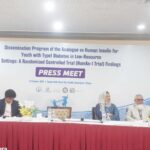
MT Desk: In May 2025, India and Pakistan fought a brief, but intense conflict triggered by a terror attack in Pahalgam, Jammu & Kashmir. India’s response, code-named Operation Sindoor, involved unprecedented air and missile strikes deep inside Pakistan.The four-day clash (May 7-10) saw both sides pushing new boundaries with drones, cruise missiles, and short-range ballistic missiles, yet carefully avoiding full-scale war. Notably, while the Indian Navy surged its western fleet into the Arabian Sea, no naval battles occurred; the deployments were signal rather than direct engagement.
After a ceasefire was brokered by the US on May 10, Indian officials were quick to boast. Defence Minister Rajnath Singh warned that any future “evil” act by Pakistan would “face the firepower and ire of the Indian Navy,” stressing that India had “paused” Operation Sindoor “on our own terms” and that its forces “had not even started showing their might”. This aggressive maritime signaling, essentially a threat that next time India would unleash naval power, was meant to project dominance.
Pakistan, however, read these signals very differently. Islamabad’s civil and military leadership dismissed India’s chest-thumping and highlighted that Pakistan’s armed forces, including its Navy, had held their own. In a post-conflict briefing, Pakistan’s Director General of Inter-Services Public Relations noted that only a “small portion” of Pakistan’s capability was used in the fight, and that the Pakistan Navy had effectively kept the Indian Navy at bay during the hostilities.
Naval officers displayed maps and slides to media, explaining how Pakistan’s fleet protected its waters and deterred India from any seaborne misadventure. Indeed, despite India’s deployment of an aircraft carrier group and other warships, they never engaged Pakistan’s coast or ports, underscoring that India’s maritime muscle-flexing was neutralized by Pakistan’s own posture and the inherent risks of escalation. Pakistan Navy’s quiet deterrence ensured that India’s much-touted naval power remained a bluff that was never called in battle.
In an era of regional naval build- ups, Pakistan has shown that security is not about matching an adversary ship-for-ship, but about making any conflict unthinkable. The Navy’s evolving conventional and nuclear deterrents serve exactly that purpose. They safeguard Pakistan’s shores and sea lanes, and in doing so, protect the nation’s economic lifeline and strategic sovereignty.
For India, the message is clear: temper your ambitions of preemptive “air+sea” offensives. Any future attempt to test Pakistan on the high seas would risk disastrous consequences, from sunken warships and economic calamity to potential nuclear escalation. No amount of boastful rhetoric can obscure the reality that Pakistan’s deterrence is robust and ready.
The quiet prowlers beneath the waves and the watchful sentinels on Pakistan’s coast ensure that war at sea will harm the instigator as much as the target. Thus, wisdom dictates refraining from lighting a fuse that could set the entire region aflame.
In the end, the Pakistan Navy’s silent vigilance contributes to strategic stability by keeping aggressive designs in check. It may operate out of the limelight, but if peace prevails in the Arabian Sea, much credit goes to those dark hulls and diligent crews who secure Pakistan’s shores, unseen, but ever prepared.





